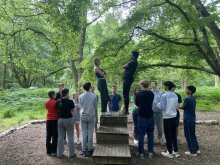






AS English Language students Kara, Oliver, Mia, Emily and Issy, all in Year 12, have explored the changing use of language due to Covid-19, including how we have created new words, the ways that war has become a metaphor for the Covid-19 relief effort and how we visualise the war against Covid.
Here, we share their fascinating essay on the subject:
Covid-related language is all around us: in adverts, news bulletins, advice sheets, editorials, not to mention social media. Looking at the language we use to communicate about the pandemic both reveals and in turn affects our perception of Covid 19 and how we manage these new times. A prominent feature of this language is a persistent use of war metaphors, which reflect some widely held attitudes towards the virus and how we should react to it.
Coronavirus as war
Shielding, frontline workers, the invisible enemy. The battle metaphor is now so familiar in relation to Covid that we rarely notice it. Certainly phrases such as the ‘war against Covid’, people on the ‘frontline’ and ‘shielding’ the vulnerable further the ideology of a nation, a world, unified in a desire to ‘beat’ the virus. Indeed, perhaps these metaphors of being at war have had something to do with our newfound solidarity over the last few months, as demonstrated by our weekly clapping for carers. But there are also some fundamental issues with the regular use of this metaphor; as George Lakoff argues in the case of this figurative reference to illnesses, it suggests that if someone dies they have ‘lost’, not to mention the gendered nature of these warrior images, which downplays the achievements of women during the pandemic. Once we are mindful of some of the implications behind this type of phrasing, maybe we can start to develop some more accurate and compassionate ways of communicating instead of this default metaphor.
Speaking a New Language
We have created new words or neologisms, as well as new meanings for old words to talk about this new world we are living in. I don’t know about you but back in March 2020 I thought that ‘bubbles’ were something you’d find in soap, but now they are also the groups you’re confined to, day by day, whether at home, work or school. Similarly, the term ‘social distancing’ would’ve been lost on me, not to mention ‘shielding’ and ‘self-isolating’. We are now using new words, such as the maskne some people experience if they have a mask which irritates their skin, or the ‘quaratinis’ people have been talking about drinking during lockdown. ‘Lockdown’ – there’s a good word – if someone had said that two years ago, would you have associated it with no shops, restaurants, cinemas or even school? It seems that we are becoming Covid bilinguals as we all become fluent in this new second language.
Unfortunately, COVID has also prompted language misuse and consequent stigmatisation. The most well-known instance of this was committed by the orange-man himself, who, during a press conference in mid-March 2020 referred to COVID-19 as the “China Virus”. Such xenophobic referencing is not a new phenomenon; a century or so ago, the 1918 influenza pandemic was known as ‘Spanish Flu’, although the virus did not originate from this country. Linguist Susan Sontag notes the damaging effects of the language used to label illness and notes the domino consequences it can trigger. Not only does it reflect a certain ideology but it can also influence understanding and behaviour.
Visualising the War against Covid
Not only our language but also the images on our posters frequently employ war metaphors when it comes to advising the public how to stay safe. Language such as ‘frontline’, ‘resistance’ and images of soldiers can regularly be found on covid posters. Sometimes the virus itself is personified as an invisible enemy who has an unfair advantage in the metaphorical fight – in the poster here the battlefield is more like a boxing ring in this retro image.

The way men and women have been are presented in these posters has sparked controversy, in particular the recent NHS poster, urging women to stay at home which was promptly withdrawn after a public outcry. The poster, with four houses and the instruction ‘STAY HOME. SAVE LIVES’ uses imperatives to send a clear message, however it is the pictures of just women completing domestic chores in a reworking of 1950s’ sexist stereotypes which met with heavy criticism. It is quite interesting to compare this with another poster urging people to stay at home with the image of three female frontline workers, positioned in the same triadic arrangement found in WW1 recruiting posters, reinforcing how active women have been in controlling and dealing with the consequences of the virus.

Interesting too are the Soviet style posters which use the colours and poses typical of this genre. These emphasise the importance of community, and how everyone must work together, contributing according to their ability. This one here has a massive syringe representing how the vaccine (and wearing masks) is the way to overcome this crisis. The wording and defiant looks on the three people’s faces reinforce the sense of a confrontation and it is interesting to see children here, as part of the metaphorical army against the virus.

Time to think
The language and images we use to refer to the Covid virus reflects not only attitudes towards the pandemic and how we should respond to it, but also our ideologies. We value solidarity, community; we adapt as does our language. Our default position of using war metaphors to describe the situation we are in is so commonplace we don’t seem to notice it anymore; perhaps it is time to stop and think a little more about what this particular image implies and whether we want to fully sign up to it.
Thank you to these five students for such an insightful and timely examination of our language in the time of Covid-19.
